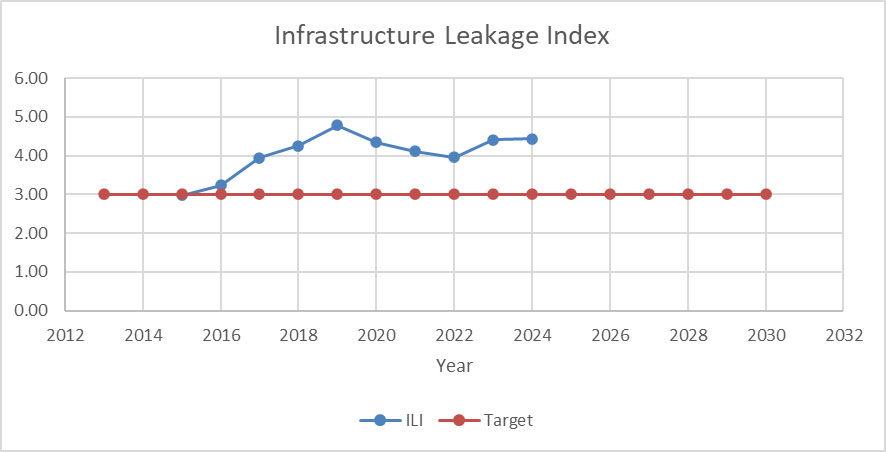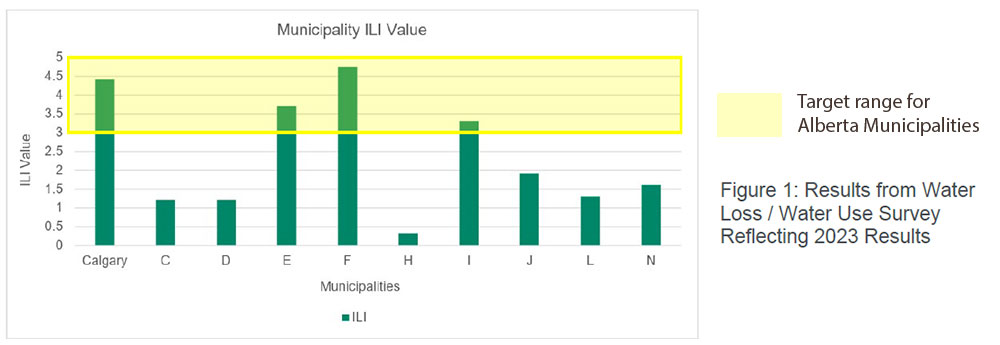Managing water loss
Water supply and availability are essential to support a growing city and region. Ensuring customers continue to have an affordable service and reducing the amount we withdraw from our rivers will continue to make Calgary a sustainable and affordable place to live.
The City continues to take proactive steps to reduce water loss including increasing proactive leak identification, addressing leaks as identified, and increasing asset management practices such as pipe replacement. These actions will result in gradual reductions over time.
As the City continues to rapidly grow, investing in water loss reduction is critical to continue to meet service demands while minimizing required infrastructure expenditures and the impacts of increased raw water withdrawal on the natural environment.
What is our water loss?
-
in 2024.
Another metric for leakage-related losses is the Infrastructure Leakage Index (ILI), which helps us better track and manage physical losses. Think of it as a score that helps water utilities understand how well they are managing and fixing leaks in their pipes. The ILI for 2024 was 4.4.
-
Did you know?
Calgary has over 5,500 km of pressurized water pipe, and over 350,000 service connections that we operate, maintain, and upgrade, to provide safe and clean drinking water to Calgarians and region every day.
Is our water loss high?
We are on the upper end of the target range as endorsed by a consortium of major Alberta municipalities (ABMunis). In late 2024, we hired a consultant to complete a review on water use trends and water loss (locally and in comparable cities). This report noted that Calgary has one of the highest ILI values of the municipalities surveyed, emphasizing the need for ongoing prioritization of water loss reduction programs. The full report is available here.
What are we doing about it?
Careful management of Calgary’s water supply and demand, investing in efficiencies, and managing the operations of Calgary’s water treatment and distribution systems ensures there is a secure water supply for Calgarians now and into the future. Actions that can reduce water loss include increasing leak survey rates, repairs, meter and data management, and increasing pipe replacement. These actions are key components of our Accelerated Water Loss program.
Expanding the leak detection program
In 2024, we met our target of leak survey on 1,000 km (1,045!) of distribution mains. This year, we are increasing the target to 1450 km and once complete, we will have surveyed almost half the distribution system including the majority of the metallic distribution mains in a two-year timeframe. In 2025, we will be surveying copper services for leaks to help identify specific areas of the city that may require targeted protection or replacement of services. A water service line is the way drinking water is delivered to properties in Calgary and connects the property plumbing to an adjacent water distribution pipe in the alley or street. Services are primarily made from copper or PVC material.
Additional repairs to fix leaking pipe
Using a balance of internal and contracted resources we will evaluate, find and fix non-surfacing leaks, in addition to any watermain break repairs that are needed.
Accelerate Asset Management Practices:
- Increase Pipe Replacement: In 2025, we plan to replace 4,000 m of watermains, increasing to 10,000 m in 2026 and targeting 15,000 m/year watermain replacement in the 2027-2030 timeframe.
- Expand existing programs on feedermain leak detection and condition assessment
Increasing our Understanding of Water Loss to Advance Strategic Water Loss Reduction
- Installing additional flow meters in the distribution system. This information, combined with updates to our metering program and leak survey information, will help us better determine where leaks may be occurring to prioritize leak survey and repair.
- Reviewing service line failures to identify types or ages of services that may be failing earlier than anticipated and to identify the root cause(s) of potential pre-mature failure.
- Rolling out of the Advanced Metering Infrastructure (AMI) program. By improving access to billing data and increasing flow meters in the distribution system, we can better identify and prioritize areas of the system for leak survey, repair, and asset replacement.
- Updating the Water Loss Strategy in 2025, including identifying an appropriate longer-term water loss target (2026-2030) and action plan.
Frequently asked questions
How did the Bearspaw South Feeder Failure impact our 2024 Water Loss?
Water loss from the transmission system was highly visible in 2024 due to the failure of the Bearspaw South Feedermain. The estimated volume lost from the failure, plus the flushing activities to ensure a safe return to service combined, is estimated at around 200 ML, or 0.5% of the total loss due to leaks for the year. This total is reflected in the overall water loss calculations.
What is an appropriate and realistic water loss target for Calgary?
The Water Loss Strategy (2019) set a target level of losses of 250 L/conn/day by 2030. Achieving this target would bring the utility to an ILI of close to 3, indicating a moderate level of losses. To be in alignment with the updated recommendation from ABMunis in 2024, the City will adopt a target of achieving an ILI of 3 by 2030.
Why is it challenging to reduce water loss?
It can be challenging to reduce water loss by identifying leaks for a variety of reasons including:
The City of Calgary has over 5,500km of pressurized water pipe, and over 350,000 service connections that we operate, maintain, and upgrade, to provide safe and clean drinking water to Calgarians and region every day.
The extent of the system presents a major challenge in identifying leaks. Additionally, breaks on mains and services in gravelly soils don't surface, instead the water runs underground so we have to go and look for them. Finally, leaks on mains and services in neighbourhoods with primarily plastic pipes are very hard to identify using traditional technologies, resulting in a need to use new technological advancements in leak locating.
Relevant links
-
Commitment to reducing water consumption by 30% over 30 years.
-
Frequently asked questions about service line leaks.



